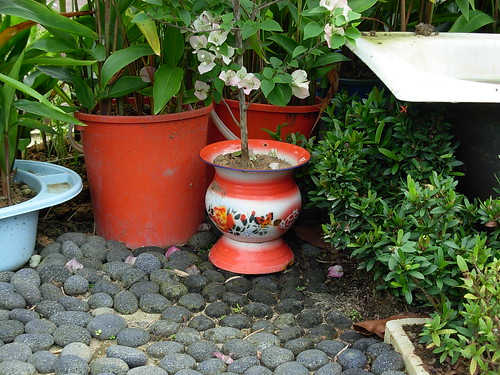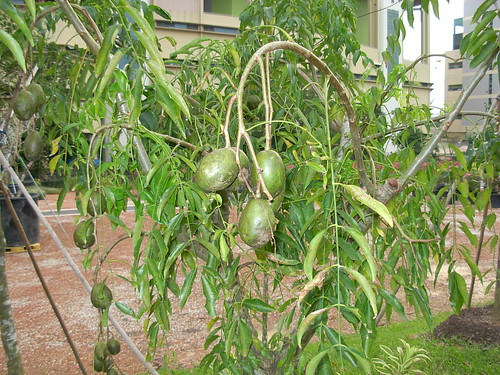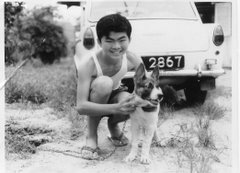I would like to pick up from where Chun See left off by sharing a bit of history about the fruit trees from my kampong days.
I grew up in a kampong near the Hill View area. There were many fruit trees in the nearby Bukit Gombak. As children, we often went up there to pluck fruits - either by climbing the tree, or using our ’ Lastic’ (catapult) to shoot down the fruits, or simply by throwing dry branches at them. All these happened about 30 years ago. Unfortunately, the Bt Gombak area is now part of the Mindef, as thus a restricted area.
Besides the common fruit trees that Chun See mentioned, I would like to touch on those fruits that are not so commonly seen in the markets; and probably not so familiar to young Singaporeans.
1) Buah Suntol
It’s not easy to find a Buah Suntol tree nowadays in Singapore. But I managed to spot one recently. Can you guess where this picture was taken?
 This tree is in the MacRitchie Reservoir just next the slope where I took the pictures of the kids playing with the Carton Boxes.
This tree is in the MacRitchie Reservoir just next the slope where I took the pictures of the kids playing with the Carton Boxes.
Here’s what the fruit looks like. (Please don’t ask how I managed to ‘pluck’ the fruits.) The taste is hard to describe, a bit sour and sweet; not like any other fruit that I can think of. Surprisingly, even a ‘kampong boy’ like Chun See have not tasted it before. If you are curious to taste it, you can go to the Thai emporium at Golden Mile Complex where they sell for about $5 per kilo and the size is much bigger than the ones below. * A note for foreign friends - 'buah' is Malay for fruit2) Buah Longlong (Bell fruit)
* A note for foreign friends - 'buah' is Malay for fruit2) Buah Longlong (Bell fruit)
The fruit is slightly bigger than an egg and has the shape of the avocado, and tastes quite sour. The skin is green when unripe, and brownish-yellow when ripe. The seed is very hard and has lots of fibres. You can find them in many shops in the pickled form.

3) Jambu Bol (Malay Apple)
I am not talking about the water apple that Chun See talked about. It is more rounded in shape. And the seed is round like a marble, and the colour is a mixture of beige and reddish stripes. The only time I saw this tree in Singapore was at the Singapore Science Centre about two years ago. By the way, if you want to see what the common jambu (water apple) tree look like, you can go down to Bishan Park – the section between Marymount Avenue and Thomson Road.
By the way, if you want to see what the common jambu (water apple) tree look like, you can go down to Bishan Park – the section between Marymount Avenue and Thomson Road.
4) Hor Pow Kor (Nam Nam)
I bet not many of you know about this fruit. Not even my ‘kampong boy’ friend Chun See has seen this one. Hor Pow Kor is the Hakka name for this fruit, because it looks like a purse. It sprouts in clusters from the tree trunk near the base of the tree. We eat this fresh immediately plucking from the tree. Your can see some pictures of what this fruit looks like at http://toptropicals.com/catalog/uid/Cynometra_cauliflora.htm.
5) Mata Kuching
This is a smaller version of the longan which we can buy in the market. The tree is very hard to climb because the trunk is very thick, so we used dry branches to throw at them.
6) Buah Limbeh
Shape is roundish, and size is slightly bigger than grape. The fruits grow like a string of beads from the branches. Tastes sour but some are sweet. Inside the fruit are seeds which we swallow (but later pass out)
7) Buah Susu
The buah susu is creeper that can still be found growing along roadside fences in many parts of Singapore. I wonder how many of you know that the ‘fruit’ is edible. It has a sweet and sour taste. But the fruit is too small to fill your stomachs though.

 The above are just some of the many fruits that I used to pluck and eat as a kampong kid. Others include buah cherry, mangosteen, buah luku, langsat and of course the more common ones like durian, mangos, rambutan and its cousin the pulasan (by the way, do you know that the seed of the pulasan can be eaten?)
The above are just some of the many fruits that I used to pluck and eat as a kampong kid. Others include buah cherry, mangosteen, buah luku, langsat and of course the more common ones like durian, mangos, rambutan and its cousin the pulasan (by the way, do you know that the seed of the pulasan can be eaten?)

This is what the area looks like today. Bukit Gombak CC and the surrounding HDB flats have all gone.
If you know where we can find these fruit trees in Singapore, please let us and our readers know. I sure would like to bring my son to see and learn about fruits that his old man used to have such a great time plucking. And if my friend Chun See can use his ‘guanxi’ with his Army Museum friends to arrange for me to visit Bukit Gombak with my son, that would be a dream come true.


 You will notice that the fruits are greenish purple in colour. Those that you buy in the market are usually light brown or orange in colour. They look rather artificial don’t they? As a matter of fact, we actually had an elderly couple ring our door bell one morning to enquire if our buah su su were real or plastic! They happened to pass by our house during their morning exercise.
You will notice that the fruits are greenish purple in colour. Those that you buy in the market are usually light brown or orange in colour. They look rather artificial don’t they? As a matter of fact, we actually had an elderly couple ring our door bell one morning to enquire if our buah su su were real or plastic! They happened to pass by our house during their morning exercise.

 You will notice that the fruits are greenish purple in colour. Those that you buy in the market are usually light brown or orange in colour. They look rather artificial don’t they? As a matter of fact, we actually had an elderly couple ring our door bell one morning to enquire if our buah su su were real or plastic! They happened to pass by our house during their morning exercise.
You will notice that the fruits are greenish purple in colour. Those that you buy in the market are usually light brown or orange in colour. They look rather artificial don’t they? As a matter of fact, we actually had an elderly couple ring our door bell one morning to enquire if our buah su su were real or plastic! They happened to pass by our house during their morning exercise.



























